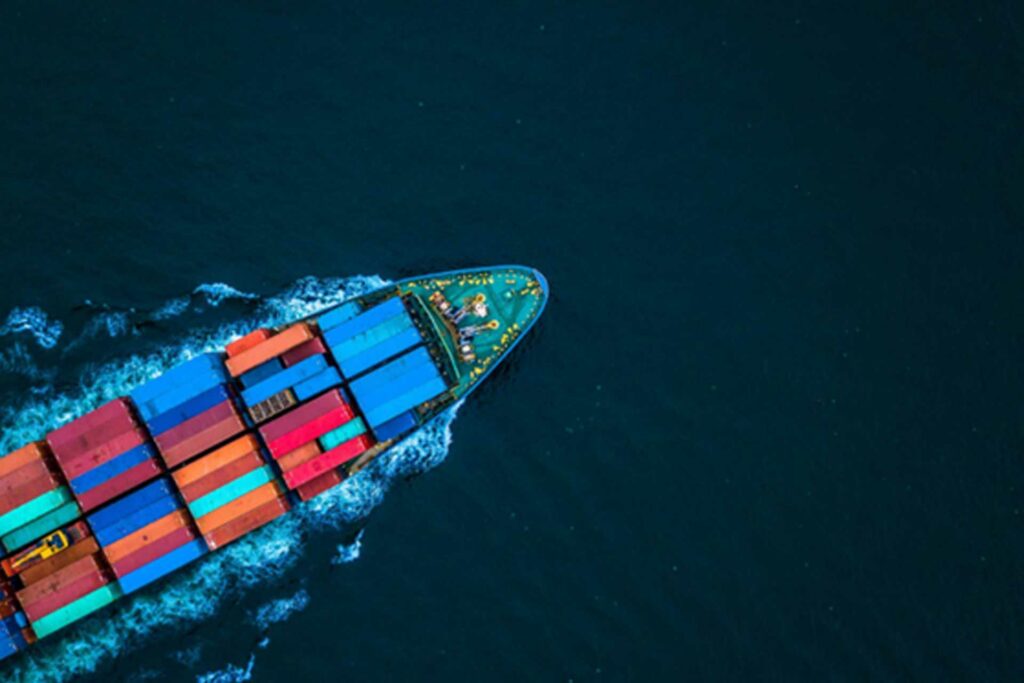Navigating the Green Wave: How India Can Lead the Sustainable Shipping Revolution?
Smrithi B
Research Intern

The global maritime industry, responsible for over 80% of international trade, is at a crossroads. While shipping remains the most carbon-efficient mode of freight transport, it contributes nearly 3% of global greenhouse gas (GHG) emissions – a figure projected to rise without intervention. As climate change accelerates, green shipping has emerged as a critical strategy to decarbonize maritime logistics while maintaining economic growth. For India, a nation with a vast coastline and ambitious trade goals, embracing green shipping is not just an environmental necessity but a strategic economic opportunity. This article explores the concept of green shipping, analyses global best practices, evaluates India’s current initiatives, and outlines a roadmap for the country to become a leader in sustainable maritime transport.
What is Green Shipping?
Green shipping refers to the adoption of environmentally sustainable practices in maritime transport to minimize ecological damage. This includes the use of alternative fuels such as liquefied natural gas (LNG), hydrogen, ammonia, and biofuels, which produce fewer emissions than conventional marine fuels. Additionally, green shipping incorporates energy-efficient vessel designs, such as aerodynamic hulls and wind-assisted propulsion, as well as digital optimization tools like AI-driven route planning and predictive maintenance. The International Maritime Organization (IMO) has set a net-zero emissions target for 2050, with interim goals of 20-40% reductions by 2030. Achieving these targets requires a combination of regulatory mandates, technological innovation, and industry collaboration—areas where India can play a pivotal role.
Global Regulatory Frameworks driving Green Shipping
The transition to sustainable shipping is being propelled by stringent international regulations. The IMO’s Initial GHG Strategy (2018, revised 2023) is the cornerstone of global efforts, mandating carbon intensity reductions through the Carbon Intensity Indicator (CII) and Energy Efficiency Existing Ship Index (EEXI). These frameworks compel shipowners to adopt cleaner technologies or face operational restrictions.
Beyond the IMO, regional policies are accelerating change. The European Union’s Emissions Trading System (EU-ETS), extended to shipping in 2024, imposes a carbon price on vessels calling at EU ports. Similarly, the FuelEU Maritime Regulation enforces progressive GHG intensity limits on marine fuels. By 2028, a global carbon pricing mechanism is expected to further standardize emission costs across trade routes. These regulations create both challenges and opportunities for Indian shipping companies, which must adapt to remain competitive in international markets.
Technological Innovations powering the Green Transition
The shift toward sustainable shipping is being enabled by cutting-edge technologies. Alternative fuels like green hydrogen and ammonia promise zero-emission propulsion, though infrastructure and cost barriers remain. LNG, while not fully carbon-neutral, offers an immediate 20-25% reduction in CO₂ emissions compared to traditional bunker fuel.
Operational advancements are equally transformative. AI-powered voyage optimization systems analyse weather patterns and currents to reduce fuel consumption by 23-35%. Wind-assisted propulsion, using rotor sails or kites, can cut fuel use by 5-20%, particularly on long-haul routes. Meanwhile, port electrification and shore power systems eliminate emissions from docked vessels, a practice already adopted in leading ports like Rotterdam and Los Angeles.
India’s Green Shipping Ambitions: Progress and Challenges
India has taken significant steps toward sustainable maritime operations. The National Centre of Excellence for Green Port & Shipping (NCoEGPS), established in collaboration with The Energy and Resources Institute (TERI), serves as a hub for policy development and innovation. The Green Tug Transition Programme aims to electrify harbor tugs, while green hydrogen pilot projects at ports like Kandla signal India’s commitment to zero-emission fuels.
However, challenges persist. Renewable energy adoption at Indian ports remains below 10%, lagging behind global leaders. Biofuel supply chains are underdeveloped, and high retrofitting costs deter fleet upgrades. Additionally, India must harmonize domestic regulations with IMO standards to avoid trade disadvantages. Addressing these gaps requires public-private partnerships, increased R&D funding, and international collaboration.
Global Best Practices
Several countries offer actionable insights for India’s green shipping transition:
- Norway has pioneered hydrogen-powered ferries, demonstrating the viability of zero-emission coastal shipping.
- Singapore, a global bunkering hub, is investing in LNG and ammonia fuel infrastructure to maintain its competitive edge.
- The EU is leveraging carbon pricing and subsidies to accelerate the adoption of clean technologies.
- The Port of Los Angeles has reduced emissions by over 50% through electrification and smart grid integration.
- In Australia, the Green Shipping Corridors Initiative is fostering low-carbon routes between major ports like Sydney and Los Angeles.
India can emulate these strategies by incentivizing green shipbuilding, scaling up renewable energy at ports, and fostering innovation through partnerships with global maritime leaders.
Charting India’s Course to a Sustainable Maritime Future
India stands at a pivotal moment in maritime history, where its actions today will determine its position in tomorrow’s green shipping economy. By leveraging strategic partnerships like the India-Australia Renewable Energy Partnership and technological collaborations with Norway and Japan, India is building a comprehensive framework for sustainable maritime development. These international alliances, combined with domestic initiatives such as the Green Tug Transition Program and port modernization efforts, create a powerful synergy between global innovation and local implementation.
The nation’s vast coastline, growing shipbuilding expertise, and renewable energy potential position it uniquely to become a leader in sustainable maritime trade. However, success will require sustained commitment to three critical areas: technology transfer through deepened international cooperation, workforce development to build green maritime capabilities, and policy alignment with evolving global standards.
As climate action becomes increasingly central to global trade, India’s ability to harmonize economic growth with environmental stewardship in its maritime sector will serve as a model for emerging economies worldwide. The journey ahead demands bold action, but the rewards – a cleaner environment, stronger economy, and leadership position in the new maritime order – make this transformation both necessary and inevitable. India’s maritime future must be green, and through strategic global partnerships, that future is within reach.
References
- Felício, J. A., Rodrigues, R., & Caldeirinha, V. (2021). Green shipping effect on sustainable economy and environmental performance. Sustainability, 13(4256).
- (2023). Initial IMO strategy on reduction of GHG emissions from ships.
- (2023). A bibliometric analysis of green shipping: Research progress and challenges for sustainable maritime transport. Journal of Marine Science and Engineering, 12(10), 1787.
- (2024). Can the shipping industry chart a course that delivers for the planet?
- (2022). Ministry of Ports, Shipping and Waterways and TERI come together to set up India’s first National Centre of Excellence in Green Port and Shipping.
- Times of India. (2025). India launches its first green hydrogen plant at Kandla port.
